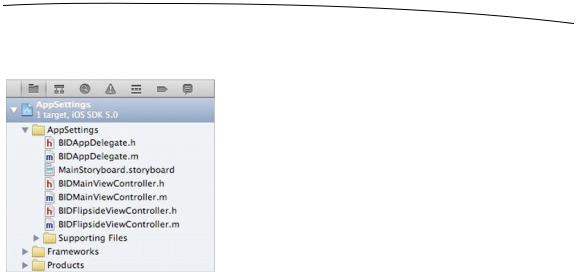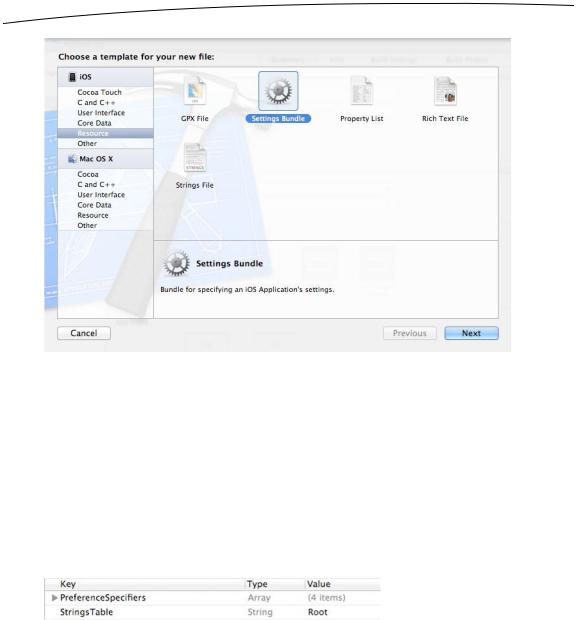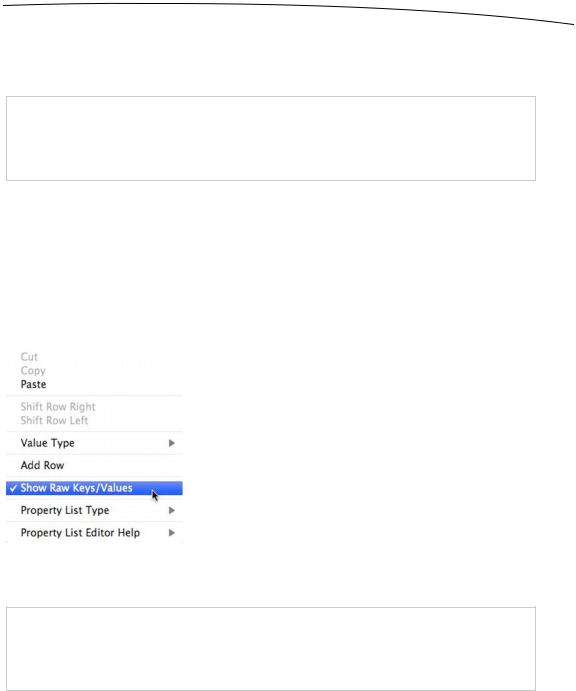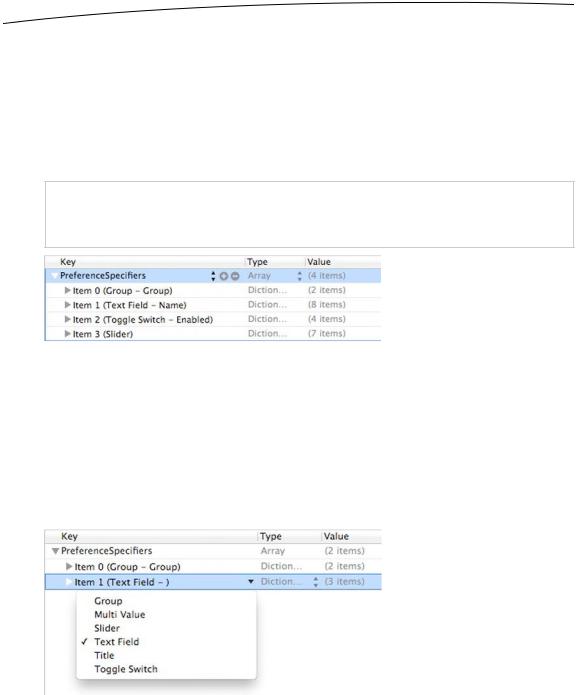
- •Contents at a Glance
- •About the Authors
- •About the Technical Reviewer
- •Acknowledgments
- •Preface
- •What This Book Is
- •What You Need
- •Developer Options
- •What You Need to Know
- •What’s Different About Coding for iOS?
- •Only One Active Application
- •Only One Window
- •Limited Access
- •Limited Response Time
- •Limited Screen Size
- •Limited System Resources
- •No Garbage Collection, but…
- •Some New Stuff
- •A Different Approach
- •What’s in This Book
- •What’s New in This Update?
- •Are You Ready?
- •Setting Up Your Project in Xcode
- •The Xcode Workspace Window
- •The Toolbar
- •The Navigator View
- •The Jump Bar
- •The Utility Pane
- •Interface Builder
- •New Compiler and Debugger
- •A Closer Look at Our Project
- •Introducing Xcode’s Interface Builder
- •What’s in the Nib File?
- •The Library
- •Adding a Label to the View
- •Changing Attributes
- •Some iPhone Polish—Finishing Touches
- •Bring It on Home
- •The Model-View-Controller Paradigm
- •Creating Our Project
- •Looking at the View Controller
- •Understanding Outlets and Actions
- •Outlets
- •Actions
- •Cleaning Up the View Controller
- •Designing the User Interface
- •Adding the Buttons and Action Method
- •Adding the Label and Outlet
- •Writing the Action Method
- •Trying It Out
- •Looking at the Application Delegate
- •Bring It on Home
- •A Screen Full of Controls
- •Active, Static, and Passive Controls
- •Creating the Application
- •Implementing the Image View and Text Fields
- •Adding the Image View
- •Resizing the Image View
- •Setting View Attributes
- •The Mode Attribute
- •Interaction Checkboxes
- •The Alpha Value
- •Background
- •Drawing Checkboxes
- •Stretching
- •Adding the Text Fields
- •Text Field Inspector Settings
- •Setting the Attributes for the Second Text Field
- •Creating and Connecting Outlets
- •Closing the Keyboard
- •Closing the Keyboard When Done Is Tapped
- •Touching the Background to Close the Keyboard
- •Adding the Slider and Label
- •Creating and Connecting the Actions and Outlets
- •Implementing the Action Method
- •Adding Two Labeled Switches
- •Connecting and Creating Outlets and Actions
- •Implementing the Switch Actions
- •Adding the Button
- •Connecting and Creating the Button Outlets and Actions
- •Implementing the Segmented Control Action
- •Implementing the Action Sheet and Alert
- •Conforming to the Action Sheet Delegate Method
- •Showing the Action Sheet
- •Spiffing Up the Button
- •Using the viewDidLoad Method
- •Control States
- •Stretchable Images
- •Crossing the Finish Line
- •The Mechanics of Autorotation
- •Points, Pixels, and the Retina Display
- •Autorotation Approaches
- •Handling Rotation Using Autosize Attributes
- •Configuring Supported Orientations
- •Specifying Rotation Support
- •Designing an Interface with Autosize Attributes
- •Using the Size Inspector’s Autosize Attributes
- •Setting the Buttons’ Autosize Attributes
- •Restructuring a View When Rotated
- •Creating and Connecting Outlets
- •Moving the Buttons on Rotation
- •Swapping Views
- •Designing the Two Views
- •Implementing the Swap
- •Changing Outlet Collections
- •Rotating Out of Here
- •Common Types of Multiview Apps
- •The Architecture of a Multiview Application
- •The Root Controller
- •Anatomy of a Content View
- •Building View Switcher
- •Creating Our View Controller and Nib Files
- •Modifying the App Delegate
- •Modifying BIDSwitchViewController.h
- •Adding a View Controller
- •Building a View with a Toolbar
- •Writing the Root View Controller
- •Implementing the Content Views
- •Animating the Transition
- •Switching Off
- •The Pickers Application
- •Delegates and Data Sources
- •Setting Up the Tab Bar Framework
- •Creating the Files
- •Adding the Root View Controller
- •Creating TabBarController.xib
- •The Initial Test Run
- •Implementing the Date Picker
- •Implementing the Single-Component Picker
- •Declaring Outlets and Actions
- •Building the View
- •Implementing the Controller As a Data Source and Delegate
- •Implementing a Multicomponent Picker
- •Declaring Outlets and Actions
- •Building the View
- •Implementing the Controller
- •Implementing Dependent Components
- •Creating a Simple Game with a Custom Picker
- •Writing the Controller Header File
- •Building the View
- •Adding Image Resources
- •Implementing the Controller
- •The spin Method
- •The viewDidLoad Method
- •Final Details
- •Linking in the Audio Toolbox Framework
- •Final Spin
- •Table View Basics
- •Table Views and Table View Cells
- •Grouped and Plain Tables
- •Implementing a Simple Table
- •Designing the View
- •Writing the Controller
- •Adding an Image
- •Using Table View Cell Styles
- •Setting the Indent Level
- •Handling Row Selection
- •Changing the Font Size and Row Height
- •Customizing Table View Cells
- •Adding Subviews to the Table View Cell
- •Creating a UITableViewCell Subclass
- •Adding New Cells
- •Implementing the Controller’s Code
- •Loading a UITableViewCell from a Nib
- •Designing the Table View Cell in Interface Builder
- •Using the New Table View Cell
- •Grouped and Indexed Sections
- •Building the View
- •Importing the Data
- •Implementing the Controller
- •Adding an Index
- •Implementing a Search Bar
- •Rethinking the Design
- •A Deep Mutable Copy
- •Updating the Controller Header File
- •Modifying the View
- •Modifying the Controller Implementation
- •Copying Data from allNames
- •Implementing the Search
- •Changes to viewDidLoad
- •Changes to Data Source Methods
- •Adding a Table View Delegate Method
- •Adding Search Bar Delegate Methods
- •Adding a Magnifying Glass to the Index
- •Adding the Special Value to the Keys Array
- •Suppressing the Section Header
- •Telling the Table View What to Do
- •Putting It All on the Table
- •Navigation Controller Basics
- •Stacky Goodness
- •A Stack of Controllers
- •Nav, a Hierarchical Application in Six Parts
- •Meet the Subcontrollers
- •The Disclosure Button View
- •The Checklist View
- •The Rows Control View
- •The Movable Rows View
- •The Deletable Rows View
- •The Editable Detail View
- •The Nav Application’s Skeleton
- •Creating the Top-Level View Controller
- •Setting Up the Navigation Controller
- •Adding the Images to the Project
- •First Subcontroller: The Disclosure Button View
- •Creating the Detail View
- •Modifying the Disclosure Button Controller
- •Adding a Disclosure Button Controller Instance
- •Second Subcontroller: The Checklist
- •Creating the Checklist View
- •Adding a Checklist Controller Instance
- •Third Subcontroller: Controls on Table Rows
- •Creating the Row Controls View
- •Adding a Rows Control Controller Instance
- •Fourth Subcontroller: Movable Rows
- •Creating the Movable Row View
- •Adding a Move Me Controller Instance
- •Fifth Subcontroller: Deletable Rows
- •Creating the Deletable Rows View
- •Adding a Delete Me Controller Instance
- •Sixth Subcontroller: An Editable Detail Pane
- •Creating the Data Model Object
- •Creating the Detail View List Controller
- •Creating the Detail View Controller
- •Adding an Editable Detail View Controller Instance
- •But There’s One More Thing. . .
- •Breaking the Tape
- •Creating a Simple Storyboard
- •Dynamic Prototype Cells
- •Dynamic Table Content, Storyboard-Style
- •Editing Prototype Cells
- •Good Old Table View Data Source
- •Will It Load?
- •Static Cells
- •Going Static
- •So Long, Good Old Table View Data Source
- •You Say Segue, I Say Segue
- •Creating Segue Navigator
- •Filling the Blank Slate
- •First Transition
- •A Slightly More Useful Task List
- •Viewing Task Details
- •Make More Segues, Please
- •Passing a Task from the List
- •Handling Task Details
- •Passing Back Details
- •Making the List Receive the Details
- •If Only We Could End with a Smooth Transition
- •Split Views and Popovers
- •Creating a SplitView Project
- •The Storyboard Defines the Structure
- •The Code Defines the Functionality
- •The App Delegate
- •The Master View Controller
- •The Detail View Controller
- •Here Come the Presidents
- •Creating Your Own Popover
- •iPad Wrap-Up
- •Getting to Know Your Settings Bundle
- •The AppSettings Application
- •Creating the Project
- •Working with the Settings Bundle
- •Adding a Settings Bundle to Our Project
- •Setting Up the Property List
- •Adding a Text Field Setting
- •Adding an Application Icon
- •Adding a Secure Text Field Setting
- •Adding a Multivalue Field
- •Adding a Toggle Switch Setting
- •Adding the Slider Setting
- •Adding Icons to the Settings Bundle
- •Adding a Child Settings View
- •Reading Settings in Our Application
- •Retrieving User Settings
- •Creating the Main View
- •Updating the Main View Controller
- •Registering Default Values
- •Changing Defaults from Our Application
- •Keeping It Real
- •Beam Me Up, Scotty
- •Your Application’s Sandbox
- •Getting the Documents Directory
- •Getting the tmp Directory
- •File-Saving Strategies
- •Single-File Persistence
- •Multiple-File Persistence
- •Using Property Lists
- •Property List Serialization
- •The First Version of the Persistence Application
- •Creating the Persistence Project
- •Designing the Persistence Application View
- •Editing the Persistence Classes
- •Archiving Model Objects
- •Conforming to NSCoding
- •Implementing NSCopying
- •Archiving and Unarchiving Data Objects
- •The Archiving Application
- •Implementing the BIDFourLines Class
- •Implementing the BIDViewController Class
- •Using iOS’s Embedded SQLite3
- •Creating or Opening the Database
- •Using Bind Variables
- •The SQLite3 Application
- •Linking to the SQLite3 Library
- •Modifying the Persistence View Controller
- •Using Core Data
- •Entities and Managed Objects
- •Key-Value Coding
- •Putting It All in Context
- •Creating New Managed Objects
- •Retrieving Managed Objects
- •The Core Data Application
- •Designing the Data Model
- •Creating the Persistence View and Controller
- •Persistence Rewarded
- •Managing Document Storage with UIDocument
- •Building TinyPix
- •Creating BIDTinyPixDocument
- •Code Master
- •Initial Storyboarding
- •Creating BIDTinyPixView
- •Storyboard Detailing
- •Adding iCloud Support
- •Creating a Provisioning Profile
- •Enabling iCloud Entitlements
- •How to Query
- •Save Where?
- •Storing Preferences on iCloud
- •What We Didn’t Cover
- •Grand Central Dispatch
- •Introducing SlowWorker
- •Threading Basics
- •Units of Work
- •GCD: Low-Level Queueing
- •Becoming a Blockhead
- •Improving SlowWorker
- •Don’t Forget That Main Thread
- •Giving Some Feedback
- •Concurrent Blocks
- •Background Processing
- •Application Life Cycle
- •State-Change Notifications
- •Creating State Lab
- •Exploring Execution States
- •Making Use of Execution State Changes
- •Handling the Inactive State
- •Handling the Background State
- •Removing Resources When Entering the Background
- •Saving State When Entering the Background
- •A Brief Journey to Yesteryear
- •Back to the Background
- •Requesting More Backgrounding Time
- •Grand Central Dispatch, Over and Out
- •Two Views of a Graphical World
- •The Quartz 2D Approach to Drawing
- •Quartz 2D’s Graphics Contexts
- •The Coordinate System
- •Specifying Colors
- •A Bit of Color Theory for Your iOS Device’s Display
- •Other Color Models
- •Color Convenience Methods
- •Drawing Images in Context
- •Drawing Shapes: Polygons, Lines, and Curves
- •The QuartzFun Application
- •Setting Up the QuartzFun Application
- •Creating a Random Color
- •Defining Application Constants
- •Implementing the QuartzFunView Skeleton
- •Creating and Connecting Outlets and Actions
- •Implementing the Action Methods
- •Adding Quartz 2D Drawing Code
- •Drawing the Line
- •Drawing the Rectangle and Ellipse
- •Drawing the Image
- •Optimizing the QuartzFun Application
- •The GLFun Application
- •Setting Up the GLFun Application
- •Creating BIDGLFunView
- •Updating BIDViewController
- •Updating the Nib
- •Finishing GLFun
- •Drawing to a Close
- •Multitouch Terminology
- •The Responder Chain
- •Responding to Events
- •Forwarding an Event: Keeping the Responder Chain Alive
- •The Multitouch Architecture
- •The Four Touch Notification Methods
- •The TouchExplorer Application
- •The Swipes Application
- •Automatic Gesture Recognition
- •Implementing Multiple Swipes
- •Detecting Multiple Taps
- •Detecting Pinches
- •Defining Custom Gestures
- •The CheckPlease Application
- •The CheckPlease Touch Methods
- •Garçon? Check, Please!
- •The Location Manager
- •Setting the Desired Accuracy
- •Setting the Distance Filter
- •Starting the Location Manager
- •Using the Location Manager Wisely
- •The Location Manager Delegate
- •Getting Location Updates
- •Getting Latitude and Longitude Using CLLocation
- •Error Notifications
- •Trying Out Core Location
- •Updating Location Manager
- •Determining Distance Traveled
- •Wherever You Go, There You Are
- •Accelerometer Physics
- •Don’t Forget Rotation
- •Core Motion and the Motion Manager
- •Event-Based Motion
- •Proactive Motion Access
- •Accelerometer Results
- •Detecting Shakes
- •Baked-In Shaking
- •Shake and Break
- •Accelerometer As Directional Controller
- •Rolling Marbles
- •Writing the Ball View
- •Calculating Ball Movement
- •Rolling On
- •Using the Image Picker and UIImagePickerController
- •Implementing the Image Picker Controller Delegate
- •Road Testing the Camera and Library
- •Designing the Interface
- •Implementing the Camera View Controller
- •It’s a Snap!
- •Localization Architecture
- •Strings Files
- •What’s in a Strings File?
- •The Localized String Macro
- •Real-World iOS: Localizing Your Application
- •Setting Up LocalizeMe
- •Trying Out LocalizeMe
- •Localizing the Nib
- •Localizing an Image
- •Generating and Localizing a Strings File
- •Localizing the App Display Name
- •Auf Wiedersehen
- •Apple’s Documentation
- •Mailing Lists
- •Discussion Forums
- •Web Sites
- •Blogs
- •Conferences
- •Follow the Authors
- •Farewell
- •Index

CHAPTER 12: Application Settings and User Defaults |
415 |
the usual application delegate class, as well as two additional controller classes and a storyboard file to contain the GUI (see Figure 12–9).
Figure 12–9. Our project created from the Utility Application template. Notice the application delegate, the storyboard, and the main and flipside view controllers.
Working with the Settings Bundle
The Settings application bases the display of preferences for a given application on the contents of the settings bundle inside that application. Each settings bundle must have a property list, called Root.plist, which defines the root-level preferences view. This property list must follow a very precise format, which we’ll talk about when we set up the property list for our application.
When the Settings application starts up, it checks each application for a settings bundle and adds a settings group for each application that includes a settings bundle. If we want our preferences to include any subviews, we need to add property lists to the bundle and add an entry to Root.plist for each child view. You’ll see exactly how to do that in this chapter.
Adding a Settings Bundle to Our Project
In the project navigator, click the AppSettings folder, and then select File New File… or press N. In the left pane, select Resource under the iOS heading, and then select the Settings Bundle icon (see Figure 12–10). Click the Next button, leave the default name of
Settings.bundle, and click Create.
www.it-ebooks.info

416 |
CHAPTER 12: Application Settings and User Defaults |
Figure 12–10. Creating a settings bundle in Xcode
You should now see a new item in the project window, called Settings.bundle. If it’s not already opened, expand Settings.bundle, and you should see two subitems: a folder named en.lproj, containing a file named Root.strings, and an icon named Root.plist. We’ll discuss en.lproj in Chapter 21 when we talk about localizing your application into other languages. Here, we’ll concentrate on Root.plist.
Setting Up the Property List
Select Root.plist, and take a look at the editor pane. You’re looking at Xcode’s property list editor (see Figure 12–11). This editor functions in the same way as the Property List Editor application in /Developer/Applications/Utilities.
Figure 12–11. Root.plist in the property list editor pane. If your editing pane looks slightly different, don’t panic. Control-click in the editing pane and select Show Raw Keys/Values from the contextual menu that appears.
Notice the organization of the items in the property list. Property lists are essentially dictionaries, storing item types and values, and using a key to retrieve them, just as an
NSDictionary does.
Several different types of nodes can be put into a property list. The Boolean, Data, Date, Number, and String node types are meant to hold individual pieces of data, but you also have a couple of ways to deal with whole collections of nodes as well. In addition to
www.it-ebooks.info

CHAPTER 12: Application Settings and User Defaults |
417 |
Dictionary node types, which allow you to store other nodes under a key, there are Array nodes, which store an ordered list of other nodes similar to an NSArray. The Dictionary and Array types are the only property list node types that can contain other nodes.
NOTE: Although you can use most kinds of objects as keys in an NSDictionary, keys in property list dictionary nodes must be strings. However, you are free to use any node type for the
values.
When creating a settings property list, you need to follow a very specific format. Fortunately, Root.plist, the property list that came with the settings bundle you just added to your project, follows this format exactly. Let’s take a look.
In the Root.plist editor pane, names of keys can either be displayed in their true, “raw” form or in a slightly more human-readable form. We’re big fans of seeing things as they truly are whenever possible, so right-click anywhere in the editor and make sure the Show Raw Keys/Values option in the contextual menu is checked (see Figure 12–12). The rest of our discussion here uses the real names for all the keys we’re going to talk about, so this step is important.
Figure 12–12. Control-click anywhere in the property list editing pane and make sure the Show Raw Keys/Values item is checked. This will ensure that real names are used in the property list editor, which makes your editing experience more precise.
CAUTION: As of this writing, leaving the property list, either by editing a different file or by quitting Xcode, resets the Show Raw Keys/Values item to be unchecked. If your text suddenly
looks a little different, take another look at that menu item and make sure it is checked.
One of the items in the dictionary is StringsTable. A strings table is used in translating your application into another language. We’ll cover the strings table in Chapter 21, when we get into localization. Since the strings table is optional, you can delete that entry by clicking it and pressing the delete key. Or you can leave it there if you prefer, since it won’t do any harm.
www.it-ebooks.info

418 |
CHAPTER 12: Application Settings and User Defaults |
In addition to StringsTable, the property list contains a node named PreferenceSpecifiers, which is an array. This array node is designed to hold a set of dictionary nodes, each representing a single preference that the user can enter or a single child view that the user can drill down into.
You’ll notice that Xcode’s template kindly gave us four nodes (see Figure 12–13). Those nodes aren’t likely to reflect our actual preferences, so delete Item 1, Item 2, and Item 3 (select each one and press the delete key, one after another), leaving just Item 0 in place.
NOTE: To select an item in the property list, it is best to click on one side or another of the Key
column, to avoid bringing up the Key column’s drop-down menu.
Figure 12–13. Root.plist in the editor pane, this time with PreferenceSpecifiers expanded
Single-click Item 0 but don’t expand it. Xcode’s property list editor lets you add rows by pressing the return key. The current selection state—including which row is selected and whether or not it’s expanded—determines where the new row will be inserted. When an unexpanded array or dictionary is selected, pressing return adds a sibling node after the selected row. In other words, it will add another node at the same level as the current selection. If you were to press return (but don’t do that now), you would get a new row called Item 1 immediately after Item 0. Figure 12–14 shows an example of hitting return to create a new row. Notice the drop-down menu that allows you to specify the kind of preference specifier this item represents—more on this in a bit.
Figure 12–14. We selected Item 0 and hit return to create a new sibling row. Note the drop-down menu that appears, allowing us to specify the kind of preference specifier this item represents.
www.it-ebooks.info

CHAPTER 12: Application Settings and User Defaults |
419 |
Now expand Item 0, and see what it contains (see Figure 12–15). The editor is now ready to add child nodes to the selected item. If you were to press return at this point (again, don’t actually press it now), you would get a new first child row inside Item 0.
Figure 12–15. When you expand Item 0, You’ll find a row with a key of Type and a second row with a key of Title. This represents a group with a title of Group.
One of the items inside Item 0 has a key of Type. Every property list node in the PreferenceSpecifiers array must have an entry with this key. The Type key is typically the first entry, but order doesn’t matter in a dictionary, so the Type key doesn’t need to be first. The Type key tells the Settings application what type of data is associated with this item.
In Item 0, the Type item has a value of PSGroupSpecifier. This indicates that the item represents the start of a new group. Each item that follows will be part of this group, until the next item with a Type of PSGroupSpecifier.
If you look back at Figure 12–4, you’ll see that the Settings application presents the application settings in a grouped table. Item 0 in the PreferenceSpecifiers array in a settings bundle property list should always be a PSGroupSpecifier so the settings start in a new group, because you need at least one group in every Settings table.
The only other entry in Item 0 has a key of Title, and this is used to set an optional header just above the group that is being started.
Now, take a closer look at the Item 0 row itself, and you’ll see that it’s actually shown as Item 0 (Group – Group). The values in parentheses represent the value of the Type item (the first Group) and the Title item (the second Group). This is a nice shortcut that Xcode gives you so that you can visually scan the contents of a settings bundle.
As shown back in Figure 12–4, we’ve called our first group General Info. Double-click the value next to Title, and change it from Group to General Info (see Figure 12–16). When you enter the new title, you may notice a slight change to Item 0. It’s now shown as Item 0 (Group – General Info) to reflect the new title.
Figure 12–16. We changed the title of the Item 0 group from Group to General Info.
www.it-ebooks.info
